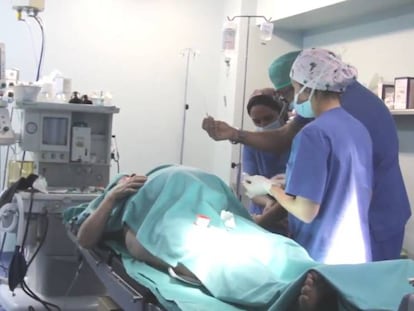The wrong sperm? Top court rules against clinic over pregnancy mix-up
Woman’s children born with different blood type, leading to accusations against her of infidelity
In 2007, a couple from Las Palmas, in the Canary Islands, decided they wanted to have a child. The man had had a vasectomy after having had a child with a previous partner. The couple contacted the Instituto Canario de Infertilidad, a privately run fertility clinic, to inquire about fertility treatment.

Sperm was taken from the man via a biopsy, and when the woman, who prefers to use the fictitious name of Ruth, began her ovulation cycle, five eggs were extracted from her. The two with the strongest chance were transferred to the woman and the couple waited until it was confirmed that Ruth was pregnant.
What should have been happy news, instead ended their relationship.
When the clinic carried out the biopsy it told the man that his sperm was unlikely to fertilize an egg. But this “low quality” sperm, as an expert witness described it, managed to fertilize four of the woman’s five eggs, creating four embryos. In hospital, Ruth’s partner learned that the twins she had given birth to belonged to the RH negative blood type, while he and Ruth were both RH positive, but never told Ruth. Over the course of the following two years Ruth says her partner repeatedly accused her of infidelity and even of being involved with “ghosts and spirits.”
The clinic accepts the ruling, but has refused to apologize, insisting its controls are foolproof
After the relationship ended in 2009, Ruth took her former partner to court for failing to look after the two children properly. At the hearing, he presented proof that he was not the father of the children. This was the first time he had confronted Ruth over the issue. She was denied assistance, while friends shunned her, believing her to have committed adultery.
Ruth then brought charges against the clinic that had carried out the procedure, saying that it had used semen from an anonymous donor and not from her partner. Two lower courts agreed with her, and now the Supreme Court has rejected the clinic’s appeals against those sentences, ordering it to pay the woman €315,000 in compensation.
Ali Mashlab del Rosario, the clinic’s medical director told EL PAÍS he would obey the ruling but does not accept the mistake and will not apologize, saying any error in the chain of custody was “impossible.”
“We have strict controls that we didn’t invent: we have spent a fortune on them,” he says.
The Spanish Fertility Society has also commented on the matter, saying: “If it is already unlikely for two semen specimens two be mixed up, anybody with experience in clinical embryology knows perfectly well that it is impossible to confuse a frozen sperm specimen obtained from a testicle that had undergone, as in this case, a vasectomy, with a specimen from ejaculated semen. There is no question of error.”
“Is it unlikely for a woman to become pregnant naturally during an assisted reproduction cycle? Fine. But the sentence doesn’t mention any evidence. The judges have taken the children into account: there are minors, and that is what counts,” says Del Rosario.
The sentence mentions that the clinic did not call the urologist who carried out the testicular biopsy as a witness, instead opting for a biologist employed by the clinic who said the biopsy was carried out at another clinic, which could have led to a mix up. She pointed out in her testimony that the documentation was handwritten by several people: “It is possible a figure could be misread: a 2 for a 7, or a 3 for an 8.”
There is no question of error Spanish Fertility Society
The Supreme Court ruling also notes that it is possible that two specimens used by the clinic belonged to men with similar names.
Finally, it points out that the semen was of poor quality but that it managed to fertilize four out of five eggs: “This once again raises doubts as to whether the micro-injection was carried out with the material” of Ruth’s partner.
The laboratory says the couple did not inform it about the pregnancy, and although post-pregnancy tests were already paid for, they preferred to hire a gynecologist, saying that this was to avoid detection that the pregnancy was through coitus with another man. Ruth said she had telephoned the clinic, while her partner said they had been told they did not need to return.
The Supreme Court ruled that it “made no sense” for a woman with no fertility issues herself to pay for expensive and uncomfortable treatment to have a child with her partner and to have unprotected sex at the same time.
It ruled out the clinic’s suggestion that she might have done so with “a wealthy man who could have maintained her and her offspring for several years,” saying: “this reflects the weight of centuries of backward stereotypes about the role and capacity of women that have nothing to do with the principles of equality and the dignity of the individual.”
English version by Nick Lyne.
Tu suscripción se está usando en otro dispositivo
¿Quieres añadir otro usuario a tu suscripción?
Si continúas leyendo en este dispositivo, no se podrá leer en el otro.
FlechaTu suscripción se está usando en otro dispositivo y solo puedes acceder a EL PAÍS desde un dispositivo a la vez.
Si quieres compartir tu cuenta, cambia tu suscripción a la modalidad Premium, así podrás añadir otro usuario. Cada uno accederá con su propia cuenta de email, lo que os permitirá personalizar vuestra experiencia en EL PAÍS.
¿Tienes una suscripción de empresa? Accede aquí para contratar más cuentas.
En el caso de no saber quién está usando tu cuenta, te recomendamos cambiar tu contraseña aquí.
Si decides continuar compartiendo tu cuenta, este mensaje se mostrará en tu dispositivo y en el de la otra persona que está usando tu cuenta de forma indefinida, afectando a tu experiencia de lectura. Puedes consultar aquí los términos y condiciones de la suscripción digital.
More information

Sixty-four-year-old woman gives birth to twins in Spain
Últimas noticias
John Berger and the loss of rural culture
From police officer to bloodthirsty kidnapper: Terror in Mexico during the years of ‘The Ear Chopper’
Alain Aspect, Nobel laureate in physics: ‘Einstein was so smart that he would have had to recognize quantum entanglement’
Imelda Castro, the woman who wants to rule the cartel battleground of Sinaloa
Most viewed
- David King, chemist: ‘There are scientists studying how to cool the planet; nobody should stop these experiments from happening’
- Reinhard Genzel, Nobel laureate in physics: ‘One-minute videos will never give you the truth’
- Oona Chaplin: ‘I told James Cameron that I was living in a treehouse and starting a permaculture project with a friend’
- Sinaloa Cartel war is taking its toll on Los Chapitos
- Mexico completes its trade shift with the entry into force of tariffs on China and countries without trade agreements










































